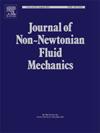剪切稀化幂律流体在靠近壁面的圆柱体周围的流动研究
IF 2.8
2区 工程技术
Q2 MECHANICS
引用次数: 0
摘要
本研究采用直接数值模拟(DNS)方法研究了雷诺数为 200 时,幂律流体在靠近壁面的圆柱体周围的流动行为。幂律指数 n 代表剪切稀化流体的典型情况(n=0.2 至 1.0),而间隙比 G/D 的范围为 0.2 至 1.0(其中 G 代表圆柱体与平面壁之间的间隙,D 代表圆柱体的直径)。本研究旨在分析幂律指数和间隙比对时均流动、涡旋动力学和气缸受力的影响。结果表明,当 G/D≥0.5 和 n≤0.5 时,由于主涡旋的诱导,在圆柱体后方形成了两个次级涡旋结构,它们处于反向旋转状态。对符号漩涡的分析表明,主漩涡和副漩涡的强度呈正相关,两者都随着间隙比的减小而减小,随着幂律指数的减小而增大。值得注意的是,当 n≤0.3 时,在 G/D=0.3 处观察到涡流脱落,而这在牛顿流体中是不存在的。通过对涡度传输方程的分析,涡度的发展归因于对流项、粘度扩散项和粘度梯度项的变化。通过对关键点的研究,解释了幂律流体在 G/D=0.3 时次级涡旋结构的形成和涡旋脱落的原因。此外,时均阻力系数 C¯D 随 n 的减小先减小后增大,并随 G/D 的减小而减小。时均升力系数 C¯L 随着间隙比的增大呈现典型的 L 型曲线,即 C¯L 先减小后增大。本文章由计算机程序翻译,如有差异,请以英文原文为准。
Research on the flow around a circular cylinder near a wall for shear-thinning power-law fluids
In this study, direct numerical simulations (DNS) was used to investigate the flow behavior of power-law fluids flow around a circular cylinder near a wall at the Reynolds number of 200. The power-law index represents the typical situation of shear-thinning fluids ( to 1.0), whereas the gap ratio ranges from 0.2 to 1.0 (where represents the gap between the cylinder and the plane wall and represents the diameter of the cylinder). This study aimed to analyze the influence of the power-law index and gap ratio on the time-averaged flow, vortex dynamics, and the force exerted on the cylinder. The results indicate that for and , two secondary vortex structures form behind the cylinder because of the induction of the primary vortices, and they are in reverse rotation. An analysis of the signed enstrophy revealed a positive correlation between the strengths of the primary and secondary vortices, both of which diminished as the gap ratio decreased and increased as the power-law index decreased. Notably, vortex shedding was observed at when , which is absent in Newtonian fluids. Through the analysis of vorticity transport equation, the development of vorticity is attributed to changes in the convection term, viscosity diffusion term and viscosity gradient term. By examining the key points, the formation of secondary vortex structure and the reason of vortex shedding at in power-law fluids are explained. Furthermore, the time-averaged drag coefficient initially decreases and then increases with decreasing , and decreases with decreasing . The time-averaged lift coefficient exhibits a typical L-type curve with increasing gap ratios, where initially decreases and then increases.
求助全文
通过发布文献求助,成功后即可免费获取论文全文。
去求助
来源期刊
CiteScore
5.00
自引率
19.40%
发文量
109
审稿时长
61 days
期刊介绍:
The Journal of Non-Newtonian Fluid Mechanics publishes research on flowing soft matter systems. Submissions in all areas of flowing complex fluids are welcomed, including polymer melts and solutions, suspensions, colloids, surfactant solutions, biological fluids, gels, liquid crystals and granular materials. Flow problems relevant to microfluidics, lab-on-a-chip, nanofluidics, biological flows, geophysical flows, industrial processes and other applications are of interest.
Subjects considered suitable for the journal include the following (not necessarily in order of importance):
Theoretical, computational and experimental studies of naturally or technologically relevant flow problems where the non-Newtonian nature of the fluid is important in determining the character of the flow. We seek in particular studies that lend mechanistic insight into flow behavior in complex fluids or highlight flow phenomena unique to complex fluids. Examples include
Instabilities, unsteady and turbulent or chaotic flow characteristics in non-Newtonian fluids,
Multiphase flows involving complex fluids,
Problems involving transport phenomena such as heat and mass transfer and mixing, to the extent that the non-Newtonian flow behavior is central to the transport phenomena,
Novel flow situations that suggest the need for further theoretical study,
Practical situations of flow that are in need of systematic theoretical and experimental research. Such issues and developments commonly arise, for example, in the polymer processing, petroleum, pharmaceutical, biomedical and consumer product industries.

 求助内容:
求助内容: 应助结果提醒方式:
应助结果提醒方式:


